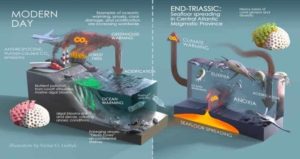
Curtin University research has shed new light on when one of the largest mass extinction events on Earth occurred, which gives new meaning to what killed Triassic life and allowed the ecological expansion of dinosaurs in the Jurassic period.
The research, published in the prestigious journal PNAS, examined biomarkers (molecular fossils) and their stable isotopic compositions which suggest the end-Triassic mass extinction of prehistoric creatures such as conodonts and phytosaurs began after a volcanic eruption spewed carbon dioxide into the atmosphere, disrupting the Earth’s natural carbon cycle and sparking a chain reaction of environmental events.
That carbon disruption led to acidic ocean waters which then affected delicate marine ecosystems, and led to other unfavorable planetary changes.
Lead author, Curtin Ph.D. graduate Dr. Calum Peter Fox, from the WA-Organic and Isotope Geochemistry Center (WA-OIGC) in Curtin’s School of Earth and Planetary Sciences, said the team analyzed biomarkers extracted from rocks collected in the United Kingdom’s Bristol Channel and found evidence of ancient microbial mats, which are complex communities of microorganisms.
“Through our analysis of the chemical signature of these microbial mats, in addition to seeing sea-level change and water column freshening, we discovered the end-Triassic mass extinction occurred later than previously thought,” Dr. Fox said.
Dr. Fox explained that previous research suggests the extinction took place where we now know microbial mats flourished and the chemical signatures left by these ancient microbes complicated the rock record, leading others to believe this is where the extinction took place.
“The microbial mats recorded in UK samples are comparable to extant microbial mats such as in Shark Bay of Western Australia. It’s amazing to consider that similar microbial communities that confounded the timing of one of Earth’s largest extinctions millions of years ago are on our shorelines and so easy to observe for ourselves,” Dr. Fox said.
John Curtin Distinguished Professor Kliti Grice, also from WA-OIGC in Curtin’s School of Earth and Planetary Sciences, said the research findings not only presented a new theory of what started the end-Triassic extinction, but also provided a type of warning for future potential mass extinction events on Earth.
“Our recent research shows that microbial mats played important functions in several mass extinction events as well as a role in preserving remains of life including soft tissue of dead organisms under exceptional circumstances,” Professor Grice said.
“Knowing more about the carbon dioxide levels present during the end-Triassic mass extinction event provides us with important details that could help protect our environment and health of our ecosystems for future generations.”
The paper is titled “Molecular and isotopic evidence reveals the end-Triassic carbon isotope excursion is not from massive exogenous light carbon.”
Reference:
Fox et al., Molecular and isotopic evidence reveals the end-Triassic carbon isotope excursion is not from massive exogenous light carbon, PNAS (2020). DOI: 10.1073/pnas.1917661117
Note: The above post is reprinted from materials provided by Curtin University.










